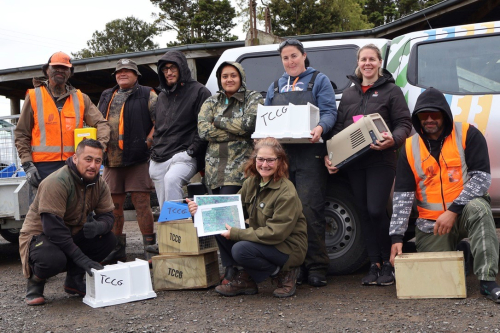
On a rainy Monday morning in Ashley Clinton, 80 predator traps were making their way to new homes as part of an exciting new trapping project in the area.
The project aims to improve biodiversity and increase native birdlife in the Tukipo catchment by designing, planning and implementing an intensive trapping programme.
Traps have now been placed in a 150 hectare site close to the Monckton Scenic Reserve with the aim of creating a predator free area which will allow existing native species to flourish and maybe one day even allow for the reintroduction of new species to the area.
“Landowners in the catchment are passionate about protecting and improving biodiversity on their farms”, says Colin Tyler, chair of the Tukipo Catchment Care Group. “Through a strategic trapping program, our primary aim is to create a predator-free environment in the catchment, allowing native species to thrive”.
The project is funded by Biodiversity Hawke's Bay, Ministry for the Environment, Hawke's Bay Regional Council and the Tukipo Catchment Care Group (TCCG). “This project is a great example of how community groups can make a real difference in enhancing our biodiversity”, says Debbie Monahan, General Manager at Biodiversity Hawke’s Bay. “It is great that Biodiversity Hawke’s Bay, in partnership with HBRC, could support such valuable work. We look forward to supporting more community initiatives in the future”.
In 2022, TCCG won the East Coast Catchment Group Award at the Ballance Farm Environment Awards. Part of the prize money from this award went towards funding a workshop run by NZ Landcare’s Sam Gibson, AKA Sam The Trap Man.
Sam encouraged the catchment to consider effective trapping solutions on a catchment wide scale and sparked excitement when he told the group that he believed that the reintroduction of native birds, including kiwi, kaka and whio, into this landscape in the future was indeed possible.
Kay Griffiths of The Conservation Company has worked on numerous projects with this catchment and was employed to design the trapping programme. “In the long term we would love to see the reintroduction of bird species such as the Pōpokotea, or whitehead, which have gone from this area now but still exist in small pockets in the Ruahines”, says Kay.
“Whilst there are a small number of animals that we may never catch, the trapping programme will reduce the number of predators within the landscape significantly which is usually enough to allow native species to thrive and that is exactly what we are trying to achieve”, says Kay.
Seven different types of traps are being used in this project to target different predators including cats, possums, rats and mustelids (ferrets, stoats and weasels) which all pose a threat to the survival of New Zealand’s native birds and other vulnerable native species including lizards and bats.
The team at Mauri Oho, Jobs for Nature, have been employed to check and re-bait many of the traps including a number of traps on land owned by BEL Group. This will complement the existing trapping work that they are already carrying out inside the Monckton Scenic Reserve.
Nina de Malmanche, Ashley Clinton landowner, is taking part in the trapping programme with 30 traps now placed over her farm. “We are thrilled to be involved in this project”, says Nina. “We are looking forward to getting the kids involved too. They will help us check and bait the traps and I am sure it will open up some interesting discussions about biodiversity”.
All the trap locations have been entered onto the Trap.NZ site and data including catches will be recorded so that results can be monitored and analysed.
Through groups such as Biodiversity Hawke’s Bay and Tukituki Land Care, the results of this project will be shared with landowners across the wider Tukituki region and beyond to show the benefits of a well designed and managed trapping project.
In September, Tukituki Land Care awarded a Demonstration grant to TCCG for a project to deal with Old Mans Beard in this same area of the catchment. This invasive weed is a prolific climber that smothers trees and native forest. The project will commence shortly and knowledge gain will again be shared.
To find out more about TCCG and Tukituki Land Care go to www.tukitukilandcare.org.
8 November 2023
Disclaimers and Copyright
While every endeavour has been taken by the Hawke's Bay Regional Council to ensure that the information on this website is
accurate and up to date, Hawke's Bay Regional Council shall not be liable for any loss suffered through the use, directly or indirectly, of information on this website. Information contained has been assembled in good faith.
Some of the information available in this site is from the New Zealand Public domain and supplied by relevant
government agencies. Hawke's Bay Regional Council cannot accept any liability for its accuracy or content.
Portions of the information and material on this site, including data, pages, documents, online
graphics and images are protected by copyright, unless specifically notified to the contrary. Externally sourced
information or material is copyright to the respective provider.
© Hawke's Bay Regional Council - www.biodiversityhb.org / 027 231 9367 / info@biodiversityhb.nz